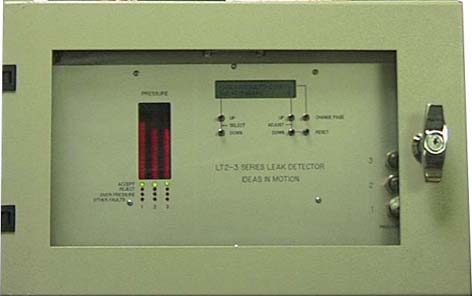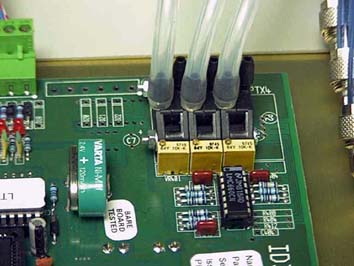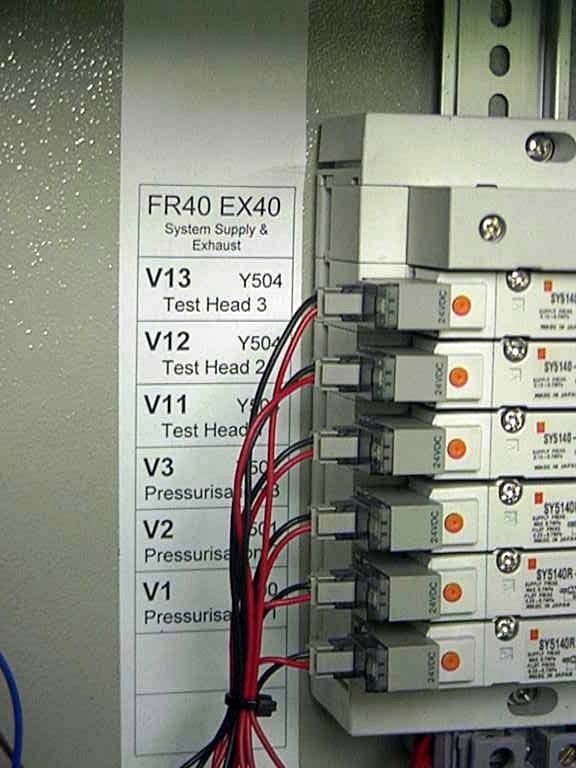LT2 Trimmer Mount Leak Detector
Dedicated for use with Uniloy-style trimmers
Customers should consider our new LTU6000 model for new installations.
 Triple Head Leak Detector
Triple Head Leak Detector
The LT2 was designed for direct mounting on Uniloy type trimmers. It interfaces directly to the trimmer control panel. There are LT2 models for both the older 110VAC AC trimmers as well as the newer 24VDC ones.
For new installations we recommend our new LTU6000 leak tester model.
1. Introduction
Improvements in electronic and pneumatic technology over the past 10 years have enabled a new leak tester to be designed which takes advantage of the latest technology.
Features which have been added include:
1.1. Microprocessor Control System
 Up to 4 channels on a single circuit board
Up to 4 channels on a single circuit board
- Reliability - Hardened against very high levels of mains spikes and static discharges.
- Flexibility - can quickly be re-programmed for special needs.
- Improved Accuracy - A 12 bit A/D converter is 32 times as accurate as other designs.
- Future-proof - Large number of spare inputs and outputs to allow future expansion provided at no extra cost.
- Easy to Set - Two line alpha-numeric display allows quick, accurate setting and display of test parameters.
- Easy to Fault Find - Diagnostics are provided from the front panel, allowing engineers to quickly verify every part of the system.
- International - Since all information is presented on the front panel display, it is easy to change the program to use another language (where the system is to be used in a non - English speaking country).
1.2. Extra Functions
Spare inputs and outputs are available to connect sensors for Handle Flash Detection, Jam detection, vision systems, alarms.
1.3. Improved Safety
Since all adjustments are from the front panel, it is no longer necessary for setters to have access to the inside of the control cabinet.
1.4. Self-Diagnostics
The cost of program memory is now very low, so it is easy to incorporate features that were not previously practical. Alarms can be displayed for:
- Incorrect threshold setting
- Test head misalignment
- Bottle crushing during test
- High reject rate.
1.5. Flexible Design
The design is highly flexible with respect to software, electronics and pneumatics.
 Modular Pneumatic System
Modular Pneumatic System1.6. Cost Effective
The circuit card design is specifically for this application, and does not incorporate unnecessary components for another machine. At the same time great care has been taken to ensure that the system is flexible, re-programmable and reliable. Spare inputs and outputs have been incorporated so that extra functions can be added whenever required.
1.7. Detail
1.7.1. Higher Reliability
This is possible due to technology improvement, reduced component count, integration of all electrical functions onto the PCB, and a better understanding of the failure mechanisms.
1.7.2. Interference Immunity
The voltage spikes produced by electromechanical switching and static discharges can cause electronics to fail. This failure can be temporary (spurious operation) or permanent (component damage). To try to prevent spurious operation of the leak tester, it was common to wire all machine connections through various interference filter cards. This had varying degrees of success. It is now possible and preferable to suppress spikes and static discharges at the leak tester PCB terminals. This results in a much neater and easier to build system. The level of immunity of new designs is extremely high, far better than most bought-in industrial PLC's.
1.7.3. Improved Operator Interface
It is now cost effective to use a full alphanumeric display rather than a simple digital readout. This allows descriptive text to appear identifying all settings , results and warnings. The system is also much more flexible as a result. All settings are from the front panel. Setting changes can be locked out if required.
1.8. New Features Summary
- Improved Reliability
- Interference Immunity
- Improved Accuracy
- Improved Safety
- Adjustable Test Pressure
- Spare Inputs For Extra Functions
- Alarm Output Option
- Correct Number Failed count for all trimmer configurations
- Push Button, Front Panel Settings
- Alphanumeric Display Of Settings And Results
- International Language Displays
- Self-Diagnostics
- Data Logging Options
- Spare I/Os brought out to standard plug
- Reduced Internal Wiring Complexity
- Panel Mounted Pneumatic Controls
2. Specification
| Electrical Power Supply | 110/120 single phase |
| Electrical Connection | 10 pin HA-10 standard plug |
| Electrical Power consumption | 50 VA maximum |
| Air Supply | 4-10 bar |
| Air Consumption | 1 litre / minute typical |
| Minimum bottle volume | 500ml - 1 pint |
| Maximum bottle volume | 25 litres - 5 gallon (unit will still work with any volume, but cycle time would be improved using another model). |
| Test Pressure | Adjustable, 5 - 50 mB. |
| Cycle Time | 1.0 - 20.0 seconds, adjustable. |
| Hole Size Detected | Dependent on cycle time and container size. For a 500ml bottle and a 2 second test time, the hole detected would be 0.1mm. |
